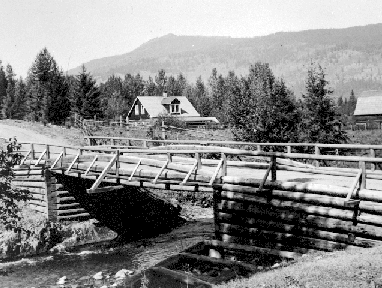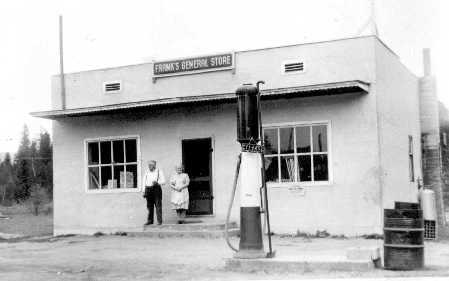History of Cherryville


The History of Cherryville
In the early 1860s, the areas first pioneers settled on the banks of Cherry Creek (now known as Monashee Creek), located in a narrow draw in the valley. It was a budding and as yet, unnamed settlement, consisting of two houses and another building being constructed.
In 1865, Cherry Creek made news when it was reported that the Cherry Creek Gold and Silver Mining Company had discovered a rich gold and silver quartz lead on the creek. Unfortunately, this claim was never proven and a brush fire destroyed the Cherry Creek Company’s cabins and mine workings. By 1876, placer gold was reported in quantity on Cherry Creek by both white and Chinese miners. .That year 20 men were reported working on Cherry Creek. Yields were $4-$5 a day. Although this gold was fine, some nuggets were found, one weighing 8.5 ounces. The placer gold from this creek is unusually high in silver with the fineness running around .720 fine.
With more miners heading into the Cherry Creek area, a route from Lumby was built by the British Columbia Department of Public Works in the summer of 1877. At that time the road was a mere eight feet wide track. With this new road, families began to arrive in the area.
Between 1863 and 1895, the original area grew into a small mining camp boasting a population of more than 100 people, half of which were Chinese miners.
From 1863 to 1930 numerous mining companies operated in the area. It had been calculated that over $125,000 worth of gold had been extracted from Cherry Creek. This figure was calculated when gold was selling at $7.50 an ounce. By today’s prices, that would be approximately $112,000,000.
All communities in the 1900s were known by their post office name. The first known post office in the area was the Jackman postal outlet, this area consisted of the area around Highway 6 and Hollingsworth Road. The Jackman Post Office ran from September 1900 to January 4, 1905, before changing its name to Hilton and operating until June 20, 1918. Postmasters included Nicholas Jackman, Avery Hiltz, William Hollingsworth, Frank Schiffer, and W.F. Darrow. Also, at this time the Camagna Post Office was operated by Ed Camagna from November 1, 1909 to April 15, 1915. This postal outlet was located near the junction of Highway 6 and North Fork Road.
In 1919, the name of Cherryville was finally christened when the Cherryville Post Office was opened with Olava Hanson as Postmistress. Mrs. Hanson had been asked by postal officials to submit a name for the post office and Cherryville was selected from Cherry Creek, Cherryville and Cherryvale. It is believed the name Cherryville came from the wild chokeberries that grew along the banks of Cherry Creek as there were no cherry trees in the area. The Cherryville Post Office remained in operation until April 30, 1947.
In the early 1900s the settlement of Richlands was established and was located on what is now Creighton Valley Road between Hammond and Burnyeat Roads. The area enticed wealthy English and American immigrants with assurances of mild climate suitable to grow orchards. The land was subdivided into 10 acre parcels with an irrigation system to be added later.
The Richlands irrigation system was an intricate system of ditches, flumes and trestles that lead from Heckman Creek along the mountainside above the valley before being gravity feed to the Richlands valley below. Construction on the irrigation ditches began in 1910, with Frank Eurit as foreman. Work proceeded on these ditches for a few years and in 1913 it was reported that pipe was being laid. In February of 1914, 100 000 ft of lumber was hauled from Eight Mile Creek into Richlands for the building of the flume system. Unfortunately, the system had to be shut down many times due to freezing and other problems.
The area grew quickly with money from England. The settlement had a general store, post office, livery stable, butcher shop and blacksmith shop. Unfortunately the weather was not suitable for orchards and the community dwindled when the first World War began and money from England ceased.
Construction on the Richlands store began in November 1910. The following March, W.F. Darrow went to Vancouver to purchase goods for the store. The goods were brought to Vernon by road and train and then to Richlands by wagon. W.F. Darrow opened his new store and post office in April of 1911. The store also included a jewelry shop.
During the First World War an internment camp was situated near the summit of the Monashee Pass. The German detainees, who were housed here through the summer months, improved the road through the pass from Cherryville to Edgewood.
The first school to be built in the area was Hilton in 1909. It was established along present day North Fork Road. The second school was Richlands; it opened its doors to students of that area in 1910. The school at Sugar Lake was in operation for ten years, from 1923 to 1933. The first Medora Creek School (along Sugar Lake Road) had classes from 1924 to 1936.
These early one room schools did not have power or running water. Heat was provided by a wood burning stove. The parents in the area supplied the wood and the older boys had the responsibility of bringing it into the classroom. Water for drinking and hand washing came from a bucket at the rear of the room. The light source was natural light coming in through the windows. The washrooms (outhouses) were located behind the school.
Various households provided room and board for the teachers. The parents were also responsible for the major cleaning of the school and the repairs to the building.
The schools had to close their doors to students when enrolment was too low and also when teachers were not available. Hilton closed for five years from 1929 to 1934 and Richlands was closed from 1919 to 1936. Medora Creek reopened in 1947 after it was closed in 1936.
In 1948 a new one-room school was built at the Hilton site and the name changed to Cherryville Superior School. The building cost approximately $18,000 and had a school population of 22. Then in 1950 another classroom was added in preparation for the amalgamation of the three area schools (Medora Creek, Richlands, and Hilton). The new two-room school opened its doors in 1951 and later became known as Cherryville School. All students were bussed to this new school. There were classes from Grade 1 through to Grade 10. Older students took correspondence courses or boarded in Vernon to attend school. Power and running water were not available in the building and heat came from a wood stove in each classroom. Bathroom facilities were behind the school.
As of 2016 Cherryville remains unincorporated and has a population of 900+ people. Cherryville has two general stores, both carrying gas, propane and liquor. It also has a museum, community hall and park, outdoor skating rink, golf course, library, farms, campgrounds, heliskiing, cat-skiing, BnB, two churches and a vast number of volunteer-run community organizations, including the Cherryville & Area Historical Society. It also boasts some of the most beautiful scenery in B.C.